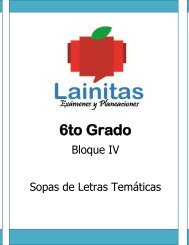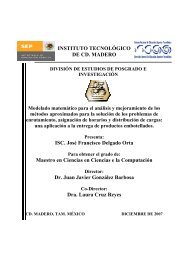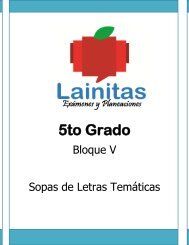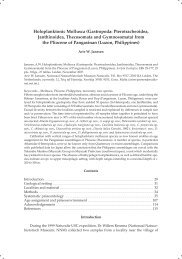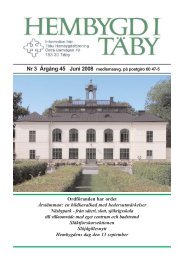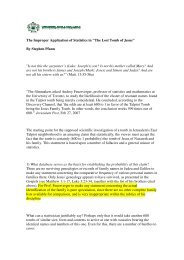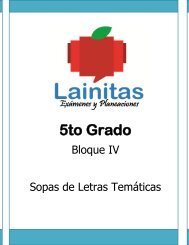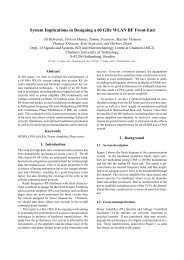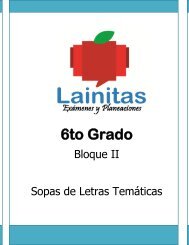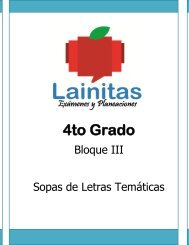CapÃtulo 3 Complejidad de algoritmos recursivos ⩠⨠⧠= > â = 0 1 0 ...
CapÃtulo 3 Complejidad de algoritmos recursivos ⩠⨠⧠= > â = 0 1 0 ...
CapÃtulo 3 Complejidad de algoritmos recursivos ⩠⨠⧠= > â = 0 1 0 ...
Create successful ePaper yourself
Turn your PDF publications into a flip-book with our unique Google optimized e-Paper software.
Instituto Tecnológico <strong>de</strong> Ciudad Ma<strong>de</strong>ro<br />
Dra. Laura Cruz Reyes<br />
Unidad I COMPLEJIDAD DE ALGORITMOS<br />
Capítulo 3 <strong>Complejidad</strong> <strong>de</strong> <strong>algoritmos</strong> <strong>recursivos</strong><br />
3.5.2 Ejemplos <strong>de</strong> recurrencias resueltas con el método <strong>de</strong> árbol <strong>de</strong> recursión<br />
El siguiente ejemplo ilustra el método <strong>de</strong> solución <strong>de</strong> recurrencias basado en árbol <strong>de</strong> recursión.<br />
2<br />
⎧ 2 Tn ( /2) + n n><br />
1<br />
Tn ( ) = ⎨<br />
⎩0 n = 1<br />
Primero se construye el árbol <strong>de</strong> recurrencia <strong>de</strong>terminando para cada nodo la función <strong>de</strong><br />
costos y el costo no recursivo. Para cada nivel se calcula el costo total.<br />
T nivel0 = n 2<br />
T(n) n 2<br />
T(n/4) (n/4) 2 T(n/4) (n/4) 2 T(n/4) (n/4) 2 T(n/4) (n/4) 2 T nivel2 = 4(n/4) 2 =n 2 /4<br />
log 2 (n)<br />
T(n/2) (n/2) 2 T(n/2) (n/2) 2<br />
T nivel1 = 2(n/2) 2 =n 2 /2<br />
T(1) 0 T nivelm = 0<br />
Un análisis visual <strong>de</strong>l árbol revela que en cada nivel el número <strong>de</strong> subproblemas aumenta en<br />
potencias <strong>de</strong> dos.<br />
( 2 0 ) →( 2 1 ) →( 2 2<br />
) →... → ( 2 m<br />
)<br />
En cada nivel el tamaño <strong>de</strong> los problemas disminuye en potencias <strong>de</strong> dos.<br />
⎛ 1 ⎞ ⎛ 1 ⎞ ⎛ 1 ⎞ ⎛ 1 ⎞<br />
⎜ n n n ... n<br />
0 ⎟→⎜ 1 ⎟→⎜ → →<br />
2 ⎟ ⎜<br />
2 2 2 2 m ⎟<br />
⎝ ⎠ ⎝ ⎠ ⎝ ⎠ ⎝ ⎠<br />
En cada nivel la complejidad algorítmica total incrementa en potencias <strong>de</strong> dos. Es importante<br />
observar que en el último nivel se tienen 2 m nodos y cada nodo es <strong>de</strong> tamaño (1/2 m )n.<br />
⎛ 1 2⎞ ⎛ 1 2⎞ ⎛ 1 2⎞ m ⎛ 1 ⎞<br />
⎜ n ...<br />
0 ⎟→⎜ n n<br />
1 ⎟→⎜ 2 ⎟→ →( 2 ) T⎜ n<br />
m ⎟<br />
⎝2 ⎠ ⎝2 ⎠ ⎝2 ⎠ ⎝2<br />
⎠<br />
Usando el patrón <strong>de</strong> complejidad y las condiciones <strong>de</strong> terminación, la recurrencia se expresa<br />
como una sumatoria.<br />
⎛ 2 1 2 1 2 1 2⎞ m ⎛ 1 ⎞<br />
Tn ( ) = ⎜n+ n+ n+ ... + n 2 T n<br />
m−1<br />
⎟+<br />
⎜ m ⎟<br />
⎝ 2 4 2 ⎠ ⎝2<br />
⎠<br />
m−1<br />
⎛ 2 1 2 1 2 1 2⎞<br />
2 1<br />
Tn ( ) = ⎜n+ n+ n+ ... + n 0 n 0<br />
m−1<br />
⎟+ = ∑ +<br />
i<br />
⎝ 2 4 2 ⎠<br />
i=<br />
0 2




